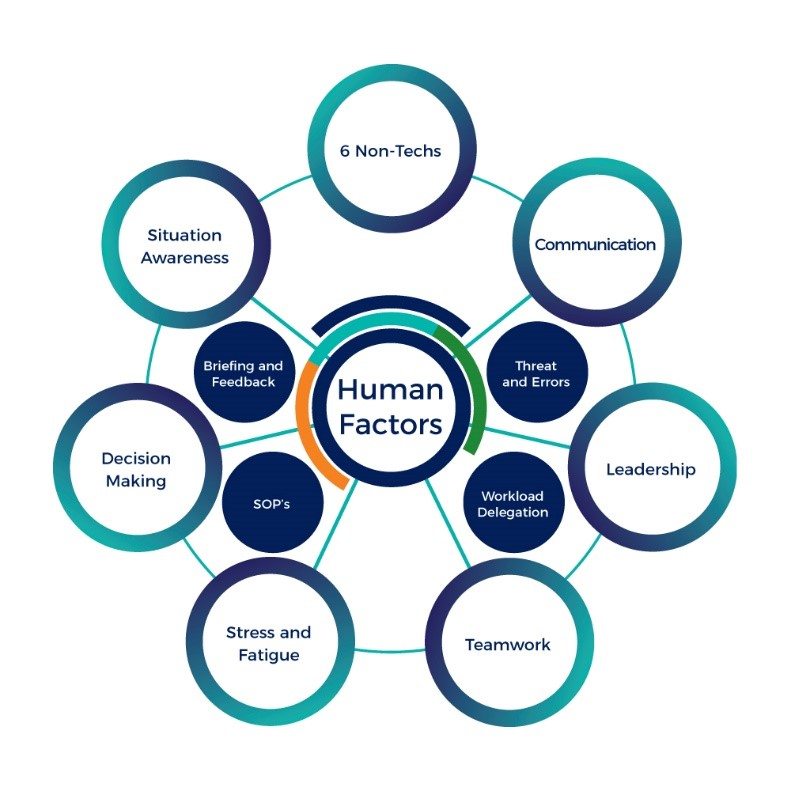Many businesses operate in demanding, dynamic and at times dangerous environments, where the consequences of human error can be very serious for employees, customers or third parties. To mitigate the risks involved with such activities, companies have developed detailed processes based on industry best practice and guidance from governing bodies. This is usually reinforced by legislation and policed by national bodies such as the Health and Safety Executive. The establishment of these steps is essential and, if supported by thorough and on-going training, will certainly reduce the number of incidents, near misses and non-compliances within the workplace.
But on their own they do not create a ‘Safety Culture’. With typically 70-80% of all workplace incidents caused by human error, process and compliance does not provide all the answers. Human Factors (HF) training – ‘The Interaction of individuals with each other, with facilities and equipment, and with management systems’ – is the bridge to establishing safer and more efficient task performance. By focusing on the cognitive and personal resource skills of technically qualified professionals, higher levels of situational awareness, decision making, communication, leadership, teamwork and management of stress and fatigue are attained. It is these ‘human factors ‘that ultimately make the difference.
In many discussions with HR and L&D directors, at Summit events and elsewhere, we noted a need and desire for a summary of some simple pointers on HF and on how to make sure that any (training) interventions actually results in sustained and embedded (behavioural) changes. So here they are. We have split them into 5 things you MUST get right and some more finessed insights that will make things sustainable
5 Things you must get right
Build Trust in your professional environment
Ensure that your teams know that they will be supported when reporting incidents and near misses, that key learning will be distilled and distributed to all employees, and that you operate a ‘Just’ rather than a ‘Blame’ culture. This needs to be visibly role modelled and led at all levels of leadership, starting with the Board.
Generate active and easy to use Feedback Loops
If your teams feel that they are being listened to, and vital changes to Standard Operating Procedures are made in a swift and comprehensive manner, they will have a sense of ownership of their environment. Use your front-line staff to put this into action
Listen and give a Voice at every point in the chain
Guarantee each team member, from the most junior to the overall leader, that they all have a right and a responsibility to ‘a Voice’ during any operation. Everyone should feel trusted and trained to ‘Stop the job’ if safety or task integrity may be compromised.
Cater for ‘Stuff Happens’
Use basic decision making methodology to support operational risk assessments. Every plan will change during its implementation, often frequently, because ‘stuff happens’ to de-rail the process. Many errors are made by supervisors and leaders guessing at what is wrong rather than diagnosing the problem effectively. Understanding how to use simple decision making models, and removing internal pressures, will prevent critical and costly errors.
Use Briefs and De-briefs at every operating level
As well ensuring that key messages are communicated and understood by all participants in a project, simple but structured Briefs and De-briefs are vital in helping to enhance Situational Awareness and improve decision making. They focus explicitly on both ‘hard’ (operational/technical) and ‘soft’(people) aspects of any operation or procedure
Some more finessed insights
When designing training interventions and to sustain actual subsequent take-up consider the following:
Learn from other industries – this is a highly useful practice but you need to strike a balance between cases and lessons from other industries and your own, especially if they can be brought to live with video and audio. What works is to gradually, over the course of a training, shift the balance to the latter and to deliver training with experts from both. This yields an optimum combination of ‘source credibility’ and relevance
Protect time for learning – everybody is time-poor and performance pressure is relentless so training time can be deemed ‘discretionary’. This can turn into an own goal. Research shows that better safety performance is a pre-cursor to better operational performance. The two can, and should be, measured in conjunction, which will show that HF training time carries a high ROI
Make training ‘real’ – there is a limit to how much people learn from theory and cases. Designing simulations requires some effort but it pays off. People recognise scenarios where errors (would) been made and they feel the progress they are making between simulations. Frequent ‘student-led ‘reflections, experiential exercises and group discussion should be used for participants to flush out and ‘own’ their own learning
Address all Human Factors – The image provides an overview. They are all interconnected, so any training, exercise and simulation should illustrate and highlight how they support each other and how deficiencies in only one can lead to a breakdown…

Leadership at all levels – probably the most hackneyed phrase in relation to HF is that it needs to be supported by all levels of leadership. In our experience this can only work if they possess a minimum level of understanding of HF and the leader’s role in it (for instance ‘giving people licence to challenge’). This can be achieved with relative ease with shorter awareness and refresher courses
‘Early focus on Learning, later on formality’ – you want people to report incidents and near misses and not just the ones where ‘the process’ was at fault but also those where ‘the person’ was. In the early stage people can be very reluctant to do this, especially if you come from a blame culture. Consider instituting a ‘Grace Period’ to build confidence. The early focus should explicitly be on sharing the Learning From Incidents (LFI) where (senior) leaders play an active, visible role in sharing the lessons and recognising those who have come forward. Note a ‘best practice’ investigations process, such as RCA (Root Cause Analysis) should be adopted to ensure investigations go deep enough to identify all causes including human.
Capture and match competencies to operations – contrary to accepted wisdom, HF competencies can be captured, measured and assessed. What is also important is to understand how ‘safety critical’ an operational environment is so that people’s competency levels can be sensibly matched to the actual severity of operational challenges. Operational complexity can be ‘measured and is a function of more obvious technical variables and of human variables that drive complexity. Into the latter come things like team size, colocation, experience, churn, external partners, performance pressures, work conditions and diversity (e.g. different languages)
Accredit – busy people with demanding operational jobs have shown more commitment when a training gives them a transferable and recognised qualification
Unified Reporting as part of an integrated SMS – too many organisations report, but fail to capture the learning because the reporting is fragmented and overcomplicated and focussed on the system rather than the human. They confuse detail with insight and equate ‘systems’ to honesty. What is much more important, especially in the early stages, is to have a simple unified system, which operates in a culture where honest reporting can flourish. Later, this can be integrated into a Safety Management System.
Having adopted most of the above, a Global Competency Manager in Oil & Gas observed “The Division has done an excellent job focusing attention and resource in the critical arena of Human Factors. The approach can easily be expanded to other populations, positively impacting all our operational teams. A remarkable change was seen in the approach to Human Factors by the participants”. And a VP Operations felt “..[it] has a positive impact on the readiness of our front-line personnel, as it improves situational awareness via combination of non-technical skills training, tackling technical challenges in a simulated work environment”
For more information on how you can help your organisation achieve that click here.









